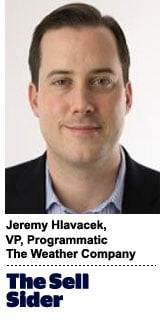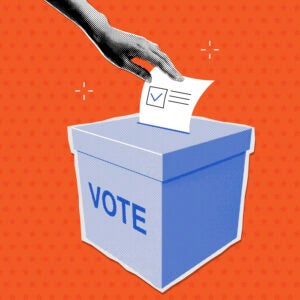 “The Sell-Sider” is a column written by the sell side of the digital media community.
“The Sell-Sider” is a column written by the sell side of the digital media community.
Today’s column is written by Jeremy Hlavacek, vice president for programmatic at The Weather Company.
Talk to some premium digital publishers these days and you will likely get a heavy dose of fear and loathing. You’ll hear how the business is “not what it used to be,” trouble is on the horizon, the sky is falling and everything is doomed.
Here are some common complaints that I hear: Buyers are more demanding than ever with viewability and data requests. Programmatic has destroyed premium CPMs. Tech companies are siphoning off too many dollars from budgets. New long-tail competition is popping up daily. And audiences are shifting to mobile where the ad market is less mature and current ad systems are complicated, messy and expensive.
In short, talking to a publisher can be a total drag. Consider yourself warned.
While it’s true that there are challenges in the market, when you look at the big picture, I would argue it may be the best time ever to be a premium digital publisher. Consider the following.
Exploding Demand
Let’s start with the dollars. Programmatic ad spending in the US alone was recently estimated at $15.43 billion by eMarketer. That’s up about $5 billion, or 50%, from 2014.
And there’s nothing but blue skies ahead with spend growing to $21.5 billion in 2016 and $26.8 billion in 2017. It’s also important to note that programmatic has helped grow the total digital ad spend pie, so this isn’t cannibalization.
EMarketer quoted programmatic spend at $3.4 billion in 2013, which was 19% of a total digital display spend of $17.89 billion. Today programmatic is 59% of a digital spend of about $26 billion. So in short, programmatic has helped grow the total market almost $10 billion in two years. Not bad.
Shrinking Supply
Over the last five years, the tech companies that run exchange marketplaces have focused on one thing: scale. The goal was to get as big as possible as quickly as possible. As a result, more than a few quality-control measures were overlooked.
However, the rise of viewability and bot and fraud detection has cut in to that volume in a huge way. For example, AppNexus recently made waves by announcing that it was cleaning out more than 60% of the impressions on its exchange to improve quality. Expect others to follow suit shortly. The net result: a big haircut for those gaudy exchange impression numbers and more focus on premium publishers.
New Technology Increasing Competition
Header bidding is all the rage at the moment, and although it’s tempting to view it as just another fad, I believe it has important strategic implications. Header bidding finally puts the entire stack up for competition with multiple partners on equal footing.
The solution is hacky at the moment, but expect this area to get developed really quickly by tech players that can put a shiny UI with nice controls on top of all of that code work that development teams across the industry are complaining about. Also, there are wrapper solutions in market with an open-source or free model, which opens up a lot of possibilities for pubs to customize the technology setups in their ad stack.
More Efficient Revenue Generation
Demand and supply are working in favor of premium publisher pricing, but beyond that the other favorable trend to remember is that maybe as much as half of the $15 billion in programmatic spend is being generated in some sort of private marketplace, premium programmatic or programmatic direct deal. This means that a publisher can work with their premium brand clients to show high-quality ads at a good price, all while using more efficient programmatic systems. All of the business that used to require endless email chains with IO changes and signoffs can now be executed much more efficiently saving countless hours for ops teams everywhere.
I believe we are at an inflection point in the programmatic market where the programmatic tide is turning in favor of premium digital publishers that have invested in their programmatic businesses and are now set up correctly to take advantage of the market.
So why are so many publishers so depressed?
My guess would be that they don’t have a solid grasp of today’s market. They think of their business as hand-sold direct sales, which is the smaller and shrinking portion of the market, and remnant open exchange, which offer low CPMs that are getting lower.
If that’s your view of the digital marketplace, then I would understand why it seems like the sky is falling.
Follow Jeremy Hlavacek (@jhlava), The Weather Company (@weathercompany) and AdExchanger (@adexchanger) on Twitter.











